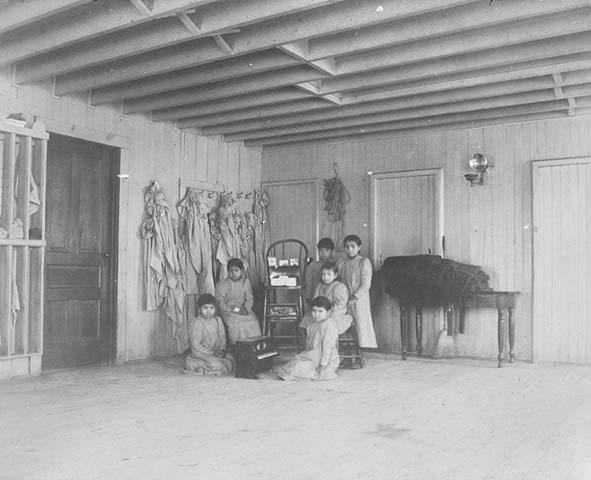
- Details
- By Jenna Kunze
Arizona House Democrats have signed onto a bill asking the Department of the Interior take a closer look at former Indian boarding school grounds in their state.
The bill, sponsored by Rep. Jennifer Jermaine, notes that Arizona has been home to the second-most Indian boarding school facilities in the nation at 51, second only to Oklahoma at 83.
Those boarding school numbers are based on preliminary research conducted over the past ten years by the Native American Boarding School Healing Coalition. Representatives from the coalition say that the Department of the Interior’s Federal Indian Boarding School Initiative is likely to find more schools and with that, more cemeteries holding childrens’ remains.
Want more Native News? Get the free daily newsletter today.
The primary goal of the initiative, announced in June by Secretary Deb Haaland in an effort to shed light on the dark history of the Indian Boarding School System, is to identify boarding school sites; the location of known and possible student burial sites located at or near school facilities; and the identities and tribal affiliations of children interred at such locations, via a report due to be released in April.
It is unclear how exactly the Department of the Interior will engage with each state’s tribal populations after the report is released. By taking action now, Jermaine and the Arizona House Democrats aren’t willing to wait to see what and how the federal initiative will include them.
Jermaine told Native News Online via email that, outside of the federal investigation, an investigation into former boarding school grounds in the state “is an issue we have been talking about and working on for four years,” she wrote. “We have done legislative proclamations for the last three years and a formal request to DOI this year.”
“We have not received updates on the federal investigation or the proposed timeline for the 51 Arizona based campuses,” Jermaine said. “Many of our MMIP (Missing and Murdered Indigenous Peoples) cold cases date back to the boarding school era and families believe there are ties to their missing loved ones.”
Tell Us What You Think
More Stories Like This
Native News Weekly (August 25, 2024): D.C. BriefsUS Presidents in Their Own Words Concerning American Indians
US Senate Unanimously Recognizes November as National Native American Heritage Month
Navajo Council Focuses on Improving Senior Services, SNAP Access for Elders
Peggy Flanagan Adds Four Senate Endorsements in Bid for U.S. Senate
Help us tell the stories that could save Native languages and food traditions
At a critical moment for Indian Country, Native News Online is embarking on our most ambitious reporting project yet: "Cultivating Culture," a three-year investigation into two forces shaping Native community survival—food sovereignty and language revitalization.
The devastating impact of COVID-19 accelerated the loss of Native elders and with them, irreplaceable cultural knowledge. Yet across tribal communities, innovative leaders are fighting back, reclaiming traditional food systems and breathing new life into Native languages. These aren't just cultural preservation efforts—they're powerful pathways to community health, healing, and resilience.
Our dedicated reporting team will spend three years documenting these stories through on-the-ground reporting in 18 tribal communities, producing over 200 in-depth stories, 18 podcast episodes, and multimedia content that amplifies Indigenous voices. We'll show policymakers, funders, and allies how cultural restoration directly impacts physical and mental wellness while celebrating successful models of sovereignty and self-determination.
This isn't corporate media parachuting into Indian Country for a quick story. This is sustained, relationship-based journalism by Native reporters who understand these communities. It's "Warrior Journalism"—fearless reporting that serves the 5.5 million readers who depend on us for news that mainstream media often ignores.
We need your help right now. While we've secured partial funding, we're still $450,000 short of our three-year budget. Our immediate goal is $25,000 this month to keep this critical work moving forward—funding reporter salaries, travel to remote communities, photography, and the deep reporting these stories deserve.
Every dollar directly supports Indigenous journalists telling Indigenous stories. Whether it's $5 or $50, your contribution ensures these vital narratives of resilience, innovation, and hope don't disappear into silence.
 The stakes couldn't be higher. Native languages are being lost at an alarming rate. Food insecurity plagues many tribal communities. But solutions are emerging, and these stories need to be told.
The stakes couldn't be higher. Native languages are being lost at an alarming rate. Food insecurity plagues many tribal communities. But solutions are emerging, and these stories need to be told.
Support independent Native journalism. Fund the stories that matter.
Levi Rickert (Potawatomi), Editor & Publisher

